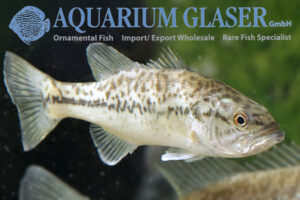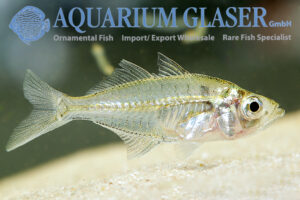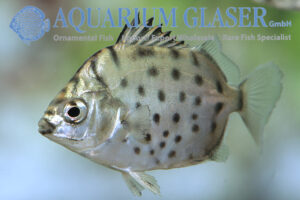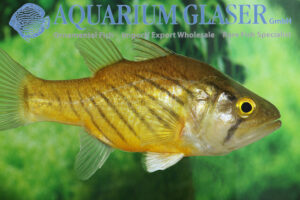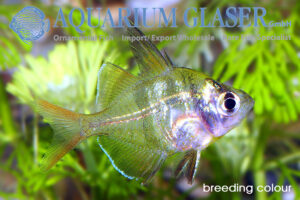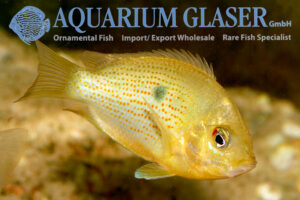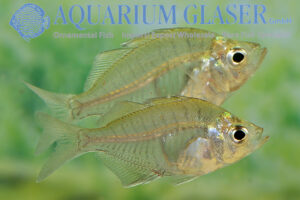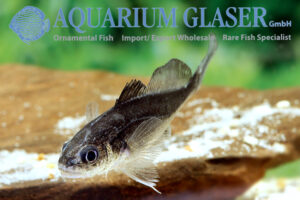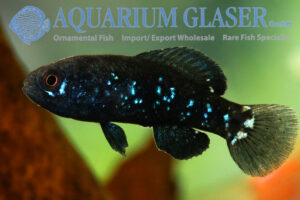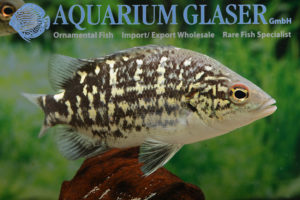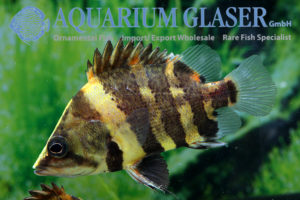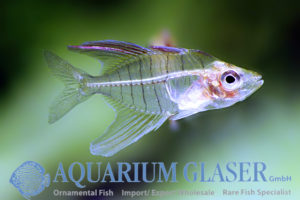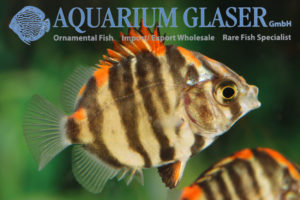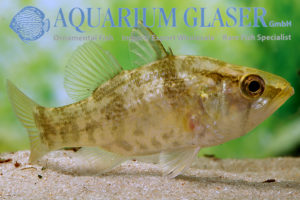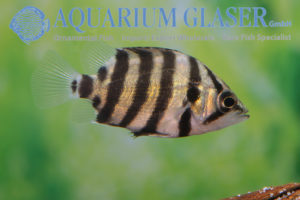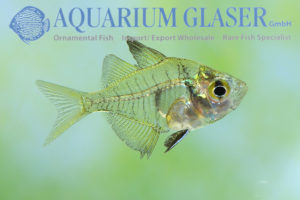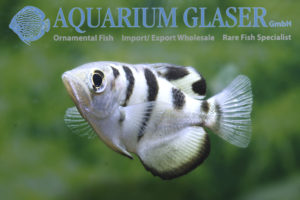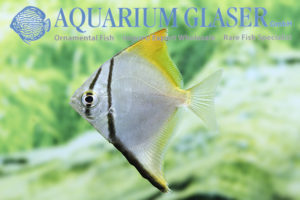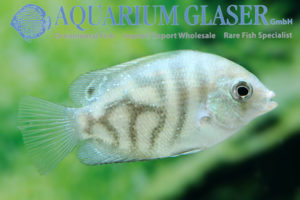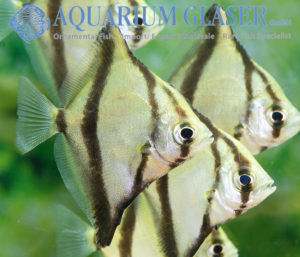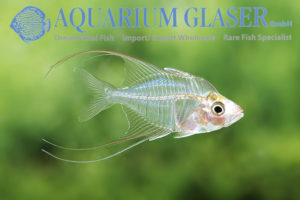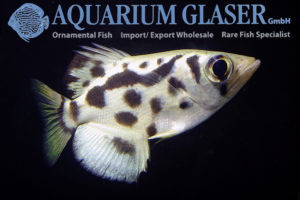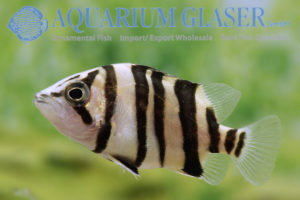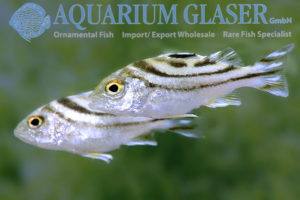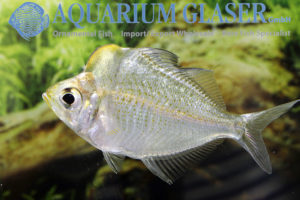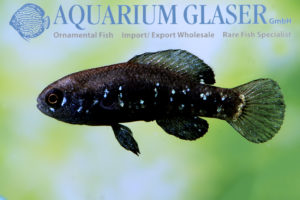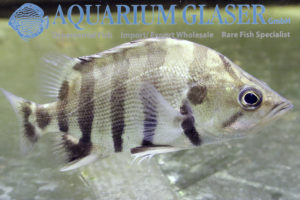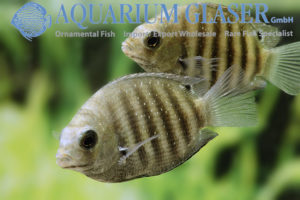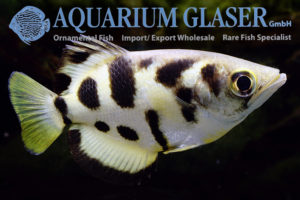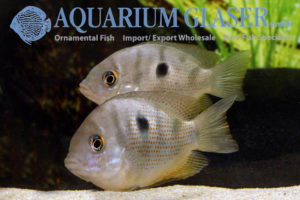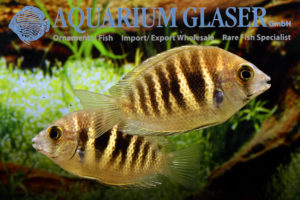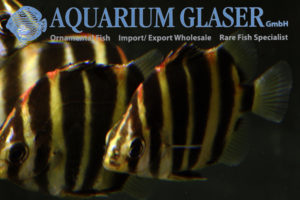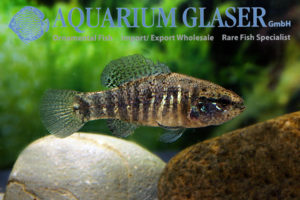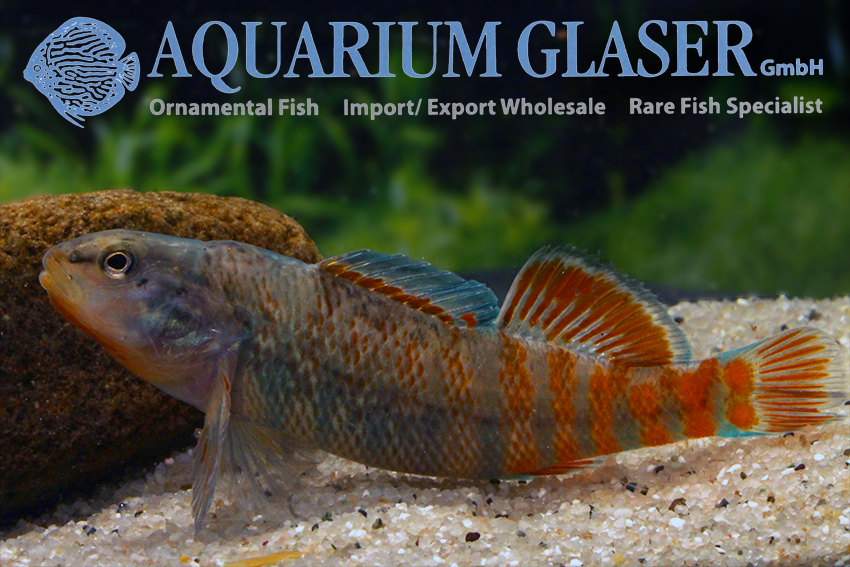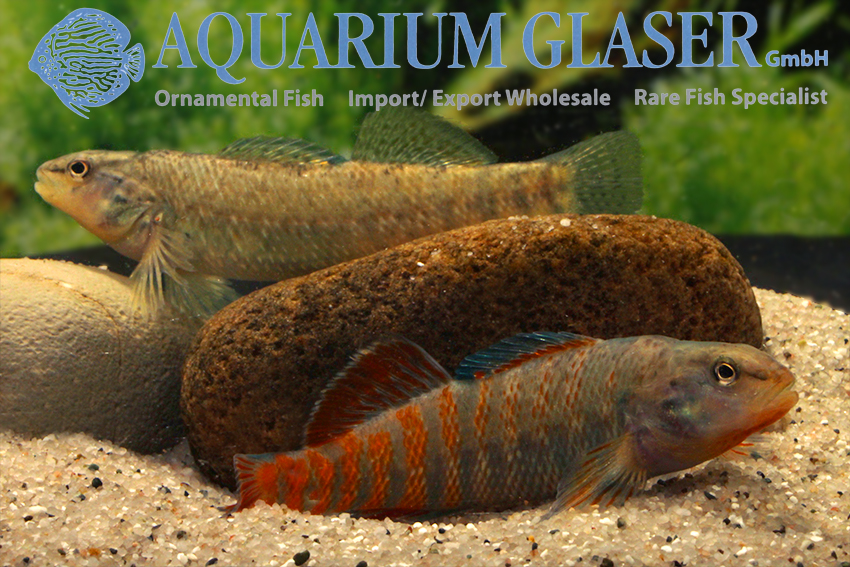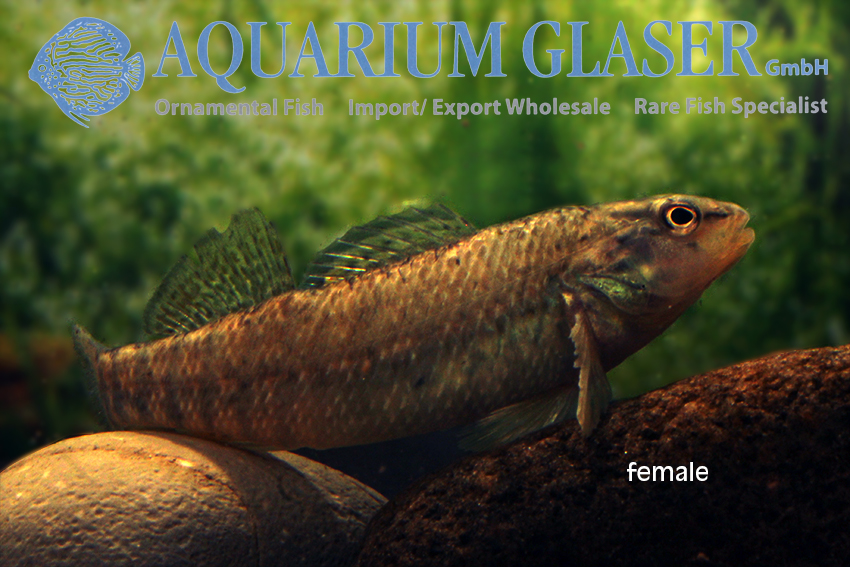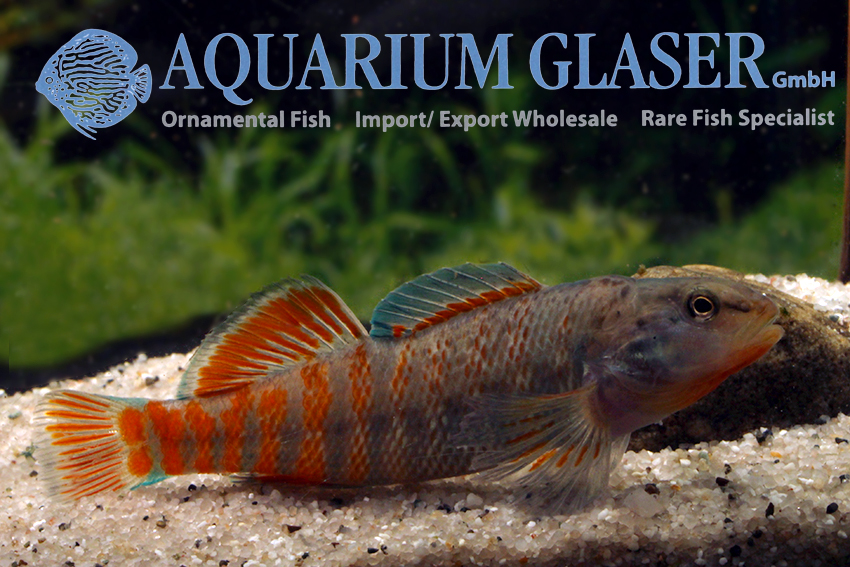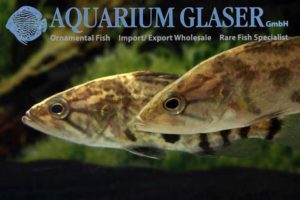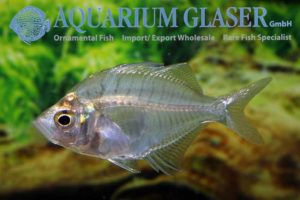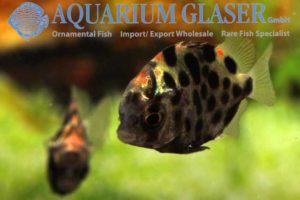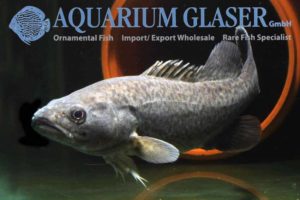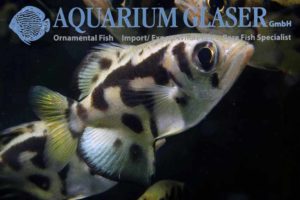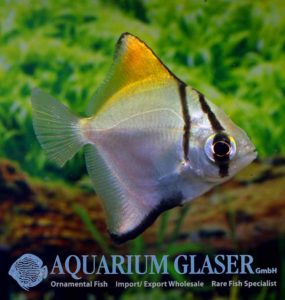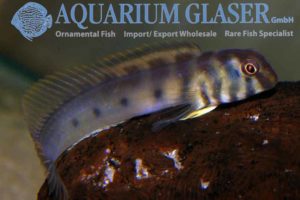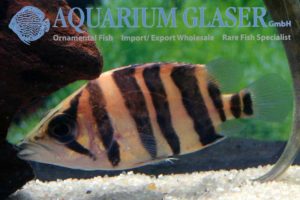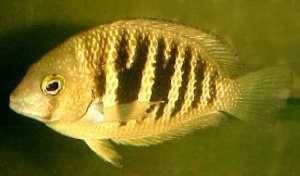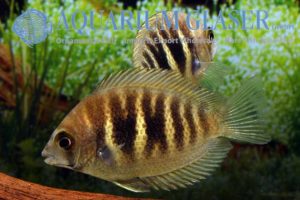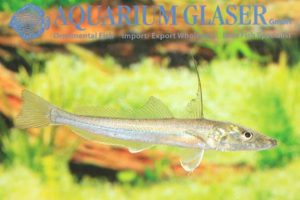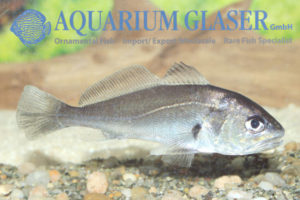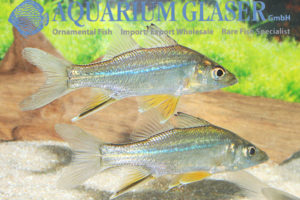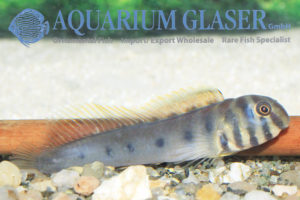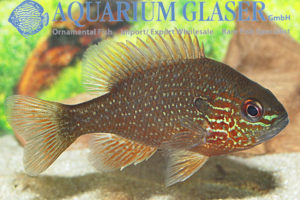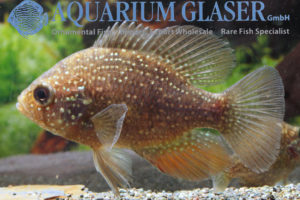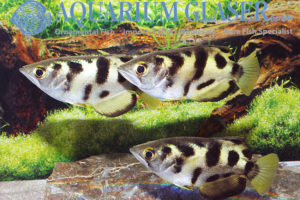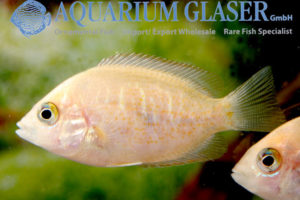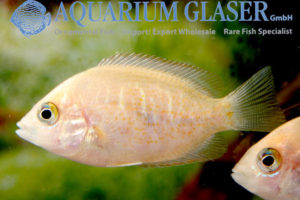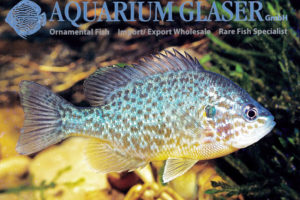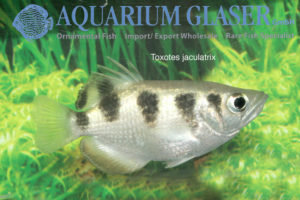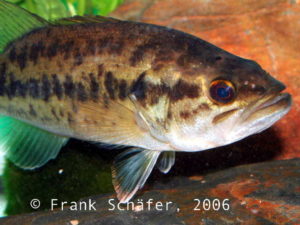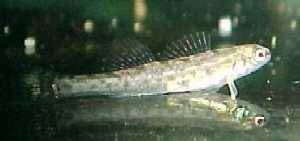Large mouth bass (Micropterus salmoides) originally come from the eastern United States where they inhabit waters from the Canadian border to Mexico. Since the 1880s, they have been introduced to Europe (and elsewhere) as sport and food fish and are now found wild in many areas. They are among the 100 most dangerous invasive species […]
25g. Perchlike fishes (7): Remaining groups (58)
-
-
Chanda nama
Until the 1950s, all aquaristically known species of glass perch were known under the genus name “Chanda”. The first major regrouping was carried out in 1955 by Fraser-Brunner, who revived the (old) genus Ambassis (with 20 species), placed the species nama in the monotypic genus Hamiltonia (i.e. only one species is assigned to it), established […]
-
Selenotoca multifasciata (S. papuensis)
There are two genera of argus fish or scats, Scatophagus and Selenotoca. Most authors currently only recognize two species in Scatophagus and one in Selenotoca, in Scatophagus the species S. argus and S. tetracanthus and in Selenotoca the species S. multifasciata. However, there are certainly considerably more species, and in Selenotoca there is probably at […]
-
Glossamia wichmanni
The mouthbrooding freshwater cardinalfish (Glossamia) are particularly rich in species on New Guinea. Of the total of 11-12 currently accepted species, 10-11 occur on New Guinea, 9-10 even only exist there. Only one species is known exclusively from Australia and another occurs on New Guinea and in Australia, namely G. aprion (see https://www.aquariumglaser.de/en/25-perchlike-fishes/glossamia-aprion-2/) Probably the […]
-
Parambassia lala
The Indian glass perch (Parambassia lala, often placed in the monotypic genus Pseudambassis) is actually an old acquaintance (first introduction: 1905), but an incredible amount of nonsense has been and still is spread about it. For example, the rumor persists that the species is a brackish water fish. But it is not, it is only […]
-
Pseudetroplus maculatus (formerly: Etroplus maculatus)
The orange chromide, Pseudetroplus maculatus, is a well-known aquarium fish and has not disappeared from the tanks of enthusiasts since it was first introduced. Recent studies indicate that the three species of cichlids from India (Pseudetroplus and Etroplus) are not so closely related to the cichlids (Cichlidae), but rather to the damselfishes (Pomacentridae). However, this […]
-
Parambassis siamensis
Formerly this species of glass perch was the most common found in the trade. It has a very wide distribution through Thailand, Vietnam, Cambodia, and Laos. However, Parambassis siamensis was most often mis-identified and traded under the name “Chanda wolffii”. P. siamensis is very similar to the Indian species P. ranga. Both are distinguished by […]
-
Boesemania microlepis
The drums (Sciaenidae), to which Boesemania microlepis belongs, are mainly known from the sea. Only a few of the approximately 300 species live permanently or occasionally in freshwater. These fish are known as “drums” because they make a very audible sound. Larger schools of these fish have already triggered submarine alarms because they cast a […]
-
Elassoma evergladei
The Pygmy Sunfish, Elassoma evergladei, is a classic dwarf fish and has been maintained and bred for many generations of aquarists. The species is best housed in a small species aquarium that does not require heating. The cute fish, growing only 2-3 cm, are completely peaceful, however the males defend an individual area against conspecifics. […]
-
Hephaestus habbemai
New fish, new questions. This is how we could characterize our import of the grunter Hephaestus habbemai. These beautiful fish come to us from Indonesia and originate from the island of New Guinea. Originally (1910) they were described from the south of the island, from the Lorentz River. The species is a pure freshwater inhabitant; […]
-
Datnioides campbelli
Among lovers of large, predatory fish, the species of the genus Datnioides (formerly: Coius) enjoy great popularity. They are calm, expressive fish that, after a sometimes somewhat tough acclimation period in which they are shy and skittish, become very attached to the keeper and provide decades of enjoyment. All Datnioides species grow to 30-40 cm […]
-
Gymnochanda ploegi
We have received this dwarf glass perch from Indonesia, which was named in honour of Alex Ploeg, who was in the passenger plane shot over the Ukraine on 17 July 2014. Gymnochanda ploegi is known so far only from West Kalimantan, the part of Borneo belonging to Indonesia. It is a pure freshwater species that […]
-
Scatophagus argus
The Scat is one of the fish species known to science almost from the beginning of scientific naming. Scatophagus argus was already described in 1766. This first description refers to a red scat. The name “rubifrons” for red scats that is always bandied about in the hobby is a purely fanciful name with no scientific […]
-
Glossamia aprion
The cardinalfishes (Apogonidae) are a species-rich (ca. 370 species), mainly marine group of mostly small-bodied, mouth-breeding perch-like fish. Very well known species are the Kauderni or Banggai Cardinalfish (Pterapogon kauderni) or the Pyjama Cardinalfish (Sphaeramia nematoptera), several other species belong to the standard assortment of marine aquaristics. Only very few species have made it into […]
-
Datnioides polota
From India (Orissa) we have received quite adorable tiger perch babies of the species Datnioides polota. Most of the only 1-2 cm long babies still have the dark baby dress, which is only interrupted in the front third of the body by a bright band. But single animals change already into the adult dress, which […]
-
Parambassis lala Bred
The dwarf glass perch, Parambassis lala, is widely distributed in South Asia; it can be found in India, Burma and Nepal. In the past this dwarf, which never grows larger than 2-3 cm, was mistaken for the juvenile of other species, which is why completely wrong size data (up to 8 cm) and also completely […]
-
Toxotes mekongensis
Archerfishes can be divided into two groups: those that live in the brackish water of estuaries, reproduce there as well (all archerfishes are free spawners without brood care) and can also live in pure seawater. These species are therefore widely distributed along the coasts of the Indo-Pacific from India to Japan and Australia. And then […]
-
Monodactylus argenteus
Moonies are magnificent brackish water fish. In pure fresh water they should be kept only temporarily, if possible, because they are very sensitive there. If it has to be freshwater, then the pH value must not drop below 7 and the nitrate value must not rise above 50 mg/l, nitrite is harmful even in very […]
-
Etroplus suratensis Bred
Mostly we receive the Indian Pearl Cichlid (Etroplus suratensis) as wild catch from South India (formerly also from Sri Lanka) or as German offspring from zoo aquariums. Now, for the first time, we have imported bred ones from Indonesia; some specimens of these offspring do not show a stripe pattern, but have an irregular bow […]
-
Monodactylus sebae
The African Mono is widely distributed along the tropical Atlantic coast of Africa. As a completely euryhaline fish, it can freely change between fresh, brackish and seawater; it prefers to stay in brackish water. In its native range M. sebae is a common fish and is caught there for food. In the past, aquaristic needs […]
-
Gymnochanda flamea
A very wonderful dwarf glassfish reached us from Indonesia: Gymnochanda flamea, the red filamentous glassfish. All Gymnochanda species (G. filamentosa, G. flamea, G. limi, G.ploegi and G. verae) are pure freshwater fish, you should never add salt to the water. Only two species, G. flamea (South-Borneo) and G. filamentosa (Malaysia, Sumatra (?), West-Borneo) have thread-like […]
-
Toxotes blythii
This archer fish that lives exclusively in freshwater originates from Burma. It has been discovered as early as 1860 and received its correct scientific name in 1892. Since then it has not been found anymore. Only in 2004 the first specimens appeared in the international trade and were celebrated as a sensation. These first specimens […]
-
Datnioides microlepis
The Indonesian Tiger Fish (Datnioides microlepis) is without any doubt the most beautiful species of Tiger Perch. These large growing predators can reach a maximum length around 50 cm and are wonderful show fish for large aquaria. But the photographed fish are still young, 4-6 cm long. There are two populations of this perch, one […]
-
Terapon jarbua
This brackish water fish – adult Terapon jarbua usually live in the sea, juveniles in brackish water, but the species is euryhalin and can be found both in the sea and in freshwater – is widespread along the coasts of South East Asia to Australia and East Africa. From the Red Sea, T. jarbua has […]
-
Parambassis pulcinella
Once more we were able to import the most peculiar species of glass perch: Parambassis pulcinella. This freshwater fish originates from clear streams in the border region between Thailand and Burma. The maximum size reported so far is about 10 cm. Against conspecifics the species is rather peaceful. They tend to tease each other sometimes […]
-
Elassoma evergladei
The pygmy sunfish, Elassoma evergladei, is a real classic among the dwarf fish. Many generations of hobbyists already enjoyed keeping and breeding the tiny species. It is best kept in a small single species tank that should not be heated. For our customers: the fish have code 404603 on our stocklist. Please note that we […]
-
Datnioides quadrifasciatus
Some aquarium fish are more of a pet than just an observation object. They grow larger than usual and communicate with their keeper. It is often not clear who is observing whom more intensively: the vertebrate in front of the aquarium or the one behind it. Datnioides quadrifasciatus clearly belongs to this category of fish. […]
-
Etroplus suratensis
After a quite long time we were able to import the Indian Pearl Spot, Etroplus suratensis, once again. Of the three species of Indian cichlids this one is the largest. Record dimensions of up to 40 cm were reported. But normally this fish becomes only about 15 cm long, it is sexually mature from about […]
-
Toxotes siamensis
We obtain some years already the very nice Toxotes sp. „Marble“ from Thailand, where it inhabits the Chao Phraya river. The up to 15-20 cm long species is a pure freshwater fish. It was very recently scientifically described as Toxotes siamensis now. During their research the authors found that only 2-3 of the currently 10 […]
-
Etroplus maculatus
The Indian cichlid, Etroplus maculatus, is a very popular aquarium fish and never disappeared after its first importation again. Recent research suggests that Etroplus is not a close relative of the cichlid family, but rather of the damselfishes (Pomacentridae). However that does not mean anything for the hobby. Etroplus maculatus can be kept and bred […]
-
Etroplus canarensis
Only three species of cichlid are found in Asia, all of them belong to the genus Etroplus. But many scientists believe that Etroplus are closer to damsels than to cichlids. Anyway, all three species are marvelous aquarium fish. Two of them, E. maculatus and E. suratensis are wide spread. There was no trace of […]
-
Scatophagus tetracanthus
We received this top rarity from the Pacific coast of Eastern Africa. For the first time ever we can offer 27 specimens. Like all scats this species is completely euryhalin, this means it can change freely between the sea and freshwater; this is their typical behaviour in the wild. Much more important than the salt […]
-
Elassoma zonatum
Even our grandfathers will remember the dwarf sunfishes. The tiny, hardly 3 cm long fish are ideal inhabitants for small tanks that are not heated. Elassoma originate from the USA. Formerly only one species of the genus was represented in the hobby, namely Elassoma evergladei. But in the meantime additional species became avialable. Among them […]
-
Coreoperca cf. liui
For the first time ever we obtained this interesting freshwater perch from southern China. The genera Coreoperca and Siniperca contain altogether 14 species. They are thought to be close relatives of the groupers (Serranidae), but are placed in a family on their own, the Sinipercidae. The fish were shipped under the name of Coreoperca kawamebari; […]
-
Parambassis siamensis
Formerly this species of glass perch was the most common found in the trade. It has a very wide distribution through Thailand, Vietnam, Cambodia, and Laos. However, Parambassis siamensis was most often mis-identified and traded under the name “Chanda wolfi”. P. siamensis is very similar to the Indian species P. ranga. Both are distinguished by […]
-
Scatophagus
Tiny scats Scats (Scatophagus) spawn in the sea. The juveniles enter brackish water zones after their development in the plankton. From the mouths of the rivers they migrate often far inland. In India currently this migration starts and we received from there charming scat babies of 1-1.5 cm length. Juvenile scats show their realtionship: the […]
-
Maccullochella peelii
Who ever looked for a really extraordinary fish as a pet will find it in this species. M. peelii is the largest freshwater fish of Australia. The popular name of Maccullochella peelii is “Murray Cod”, after the Murray River. The average length of adults is about 60 cm and 2-3 kg weight; but the largest […]
-
Toxotes blythii
This archer fish that lives exclusively in freshwater originates from Burma. It has been discovered as early as 1860 and received its correct scientific name in 1892. Since then it has not been found anymore. Only in 2004 the first specimens appeared in the international trade and were celebrated as a sensation. These first specimens […]
-
Monodactylus argenteus
Are you planning already your tanks for the upcoming year? Maybe you try a brackish water tank? A large aquarium with a school of monos (Monodactylus argenteus) is a real eyecatcher and a perfect opportunity to learn about all the other interesting species that like it a bit salty. Text & photos: Frank Schäfer
-
Omobranchus zebra
Once more we could import this charming freshwater blennie. For more information on the species, please see http://www.aquariumglaser.de/en/news/Omobranchus_zebra_en/ For our customers: the fish have code 439742 on our stocklist. Please note that we exclusively supply the wholesale trade. Text & photos: Frank Schäfer
-
Datnioides microlepis
Finally we were able to import once more the most beautiful species of tiger perch, the Indonesian Tiger Fish. These large growing predators can reach a maximum length around 50 cm and are wonderful show fish for large aquaria. But our imports are still young, 4-6 cm long. There are two populations of this perch, […]
-
Etroplus canarensis
Only three kinds of cichlids are found in Asia, all of them belong to the species Etroplus. But many scientists believe that Etroplus are closer to damsels than to cichlids. However, all three kinds are marvelous aquarium fish. Two of them, E.macultus and E. suratensis are wide spread. There was no trace of E. canarensis […]
-
Etroplus canarensis
Finally we are able to offer once more the extremely rare and extraordinary beautiful Indian Wasp Cichlid. In contrast to its relatives, this species is an inhabitant of pure freshwater only and never enters brackish water zones. Available in limited numbers only! For our customers: the fish have code 415751 on our stocklist. Please note […]
-
Sillaginopsis panijus
The difference between “foodfish” and “ornamental fish” is often hard to tell. For example, who in Europe would term the zebra barb (Danio rerio) a foodfish? Nevertheless hundreds of thousands of these tiny animals are collected daily in India, become dried and are sold as a spice. On the other hand young examples of attractive […]
-
Plagioscion squamosissimus
Croakers, also called Drums (Sciaenidae) are a fish family that comprises about 290 species. Most of them are marine, but some occur exclusively in fresh water. In South America about 20 species and 4 genera are known to live in fresh water. The smallest among them becomes only 7 cm long (Pachypops pigmaeus), most become […]
-
Centropomus unionensis
The snooks (Centropomus) are distributed in the New World; currently 12 species are recognized. Persons that are reminiscent of giant perches (Lates) by looking at snooks are not wrong: until quite recently the snooks and the giant perches were united in a single family, Centropomidae. We were now able to import a pretty species of […]
-
Omobranchus zebra
Omobranchus belongs to the Blenniidae family, most of which live in marine environments. Due to their funny behaviour and the generally easy keeping the blennies are favorite fish of the marine hobbyists. There are only very few species that settle permanently in fresh or brackish water. One of the latter is the pretty Omobranchus zebra, […]
-
Lepomis megalotis
Sunfishes belong to the most colourful species of coldwater fish. The most widespread species in the hobby is Lepomis gibbosus, but the genus comprises not less than 12 species. Lepomis megalotis is native from NE-Mexico to the Great Lakes in the US and is additionally introduced in many countries. Up to six subspecies have been […]
-
Enneacanthus gloriosus
The Bluespotted Sunfish (Enneacanthus gloriosus) is a coldwater fish and a real oldtimer among aquarium fish. Aquarists used to name the up to 7.5 cm long fish “working class discus”, due to its brillant colours and the nice behaviour. However, it was never as expensive as the discus. Bluespotted Sunfish occur in nature along the […]
-
Toxotes sp. New!
A new species of Archerfish! Recently we received a shipment containing archerfishes (Toxotes) from Thailand. Most of the shipment were T. jaculatrix (see http://www.aquariumglaser.de/en/toxotes-jaculatrix_en_1076.html) and some T. chatareus (see http://www.aquariumglaser.de/en/toxotes-chatareus_en_1044.html). But a closer look showed also four specimens of an unique colored archerfish, which we have never seen so far and which fits to none […]
-
Etroplus maculatus
The Indian cichlid, Etroplus maculatus, is a very popular aquarium fish and never disappeared after its first importation again. Recent research suggests that Etroplus is not a close relative of the cichlid family, but rather of the damselfishes (Pomacentridae). However that does not mean anything for the hobby. Etroplus maculatus can be kept and bred […]
-
Etroplus maculatus “Gold-Blue”
The Indian cichlid, Etroplus maculatus, is a very popular aquarium fish and never disappeared after its first importation again. Recent research suggests that Etroplus is not a close relative of the cichlid family, but rather of the damselfishes (Pomacentridae). However that does not mean anything for the hobby. Etroplus maculatus can be kept and bred […]
-
Lepomis gibbosus
The pumpkinseed (Lepomis gibbosus) is one of the most beautiful coldwater fishes. Moreover it has a very interesting behaviour. The species originates from central parts of the North American continent. The continental climate (hot summers, cold winters) makes the pumkinseed a hardy fish and so it was transferred by humans to many regions as a […]
-
Toxotes jaculatrix
Seven species of Archerfishes (Toxotes) are known. Three of them (T. lorentzi and T. kimberleyensis from Australia and T. microlepis from South East Asia) are usually found in fresh water. Two are practically unknown, at least they have not been kept in aquaria so far: T. blythi from Burma and T. oligolepis from the Moluccas. […]
-
Micropterus salmoides
Something special for your pond. The Largemouth Bass originates from the eastern part of the United States where they occur from the Canadian border down to Mexico. In the meantime they were spread in numerous countries as game fish and can therefore be found also in Europe. They prefer quiet, well warmed waters without a […]
-
Etheostoma fusiforme
October 2003: This week we received a limited number of Etheosoma fusiforme. These goby-like perches are also called Darters and originates from North America. Darter males inspire during the courtship with beautiful colors. During the summer months this species can be held also in the domestic garden pond. (Photo F. Schäfer, Text K. Diehl)
Only in the transit…
There are not many species of fish in which the demand is greater than the number of offered animals. The Rainbow Darter (Etheostoma caeruleum) from North America belongs to these exceptional species. The pretty, small species – it attains a maximum length of 7-8 cm – has been imported as early as 1899, but it always stayed rare.
Now we obtained 10 adult bred specimens, which are, however, not for sale, but which will go to another breeder. We hope the new breeder will be able to produce a good number of offspring for us.
Although the Rainbow Darter inhabits cool, fast running watter in the wild it is all but demanding. The species deposits the eggs in the ground. Hopefully they will do it in great numbers in their new home and then we will be able to offer the pretty fish to all who are interested in it.
Text & photos: Frank Schäfer
Sunfish special!
Enneacanthus gloriosus

The Bluespotted Sunfish (Enneacanthus gloriosus) is a coldwater fish and a real oldtimer among aquarium fish. Aquarists used to name the up to 7.5 cm long fish “working class discus”, due to its brillant colours and the nice behaviour. However, it was never as expensive as the discus.
Bluespotted Sunfish occur in nature along the southeastern coastal region of the US. Here they live in ponds and slow moving rivers with clear water and a dense vegetation. In the aquarium they are not undemanding. They need clean, clear and preferably soft and slightly acidic water. Moreover they are said to be very anxious and can die when shocked. Neverless it is not a big problem to fulfill these demands and a tank with Banded Sunfish belongs to the most beautiful looks one can have in the whole aquarium hobby.
Like all sunfish, the Banded Sunfish usually refuses flake food, it is better to feed them on frozen and live food The term “coldwater fish” is often misunderstood. In this case it does not mean that the tank for sunfish has to be cooled in living rooms. These species have no problem with temperatures as high as 26°C for some time. However, they need a cool period during winter at 4-10°C, otherwise they will not breed.
In Central Europe this species will not survive extreme winters in the garden pond, so it is better to bring them in a cool cellar room from December to March.
For our customers: the fish has code 803803 on our stocklist. Please note that we exclusively supply the wholesale trade.
Lexicon: Enneacanthus: ancient Greek, means “with nine spines”. This refers to the structure of the dorsal fin. gloriosus: Latin, means “glorious”.
Common name: Bluespotted sunfish
Text & photo: Frank Schäfer
Enneacanthus chaetodon
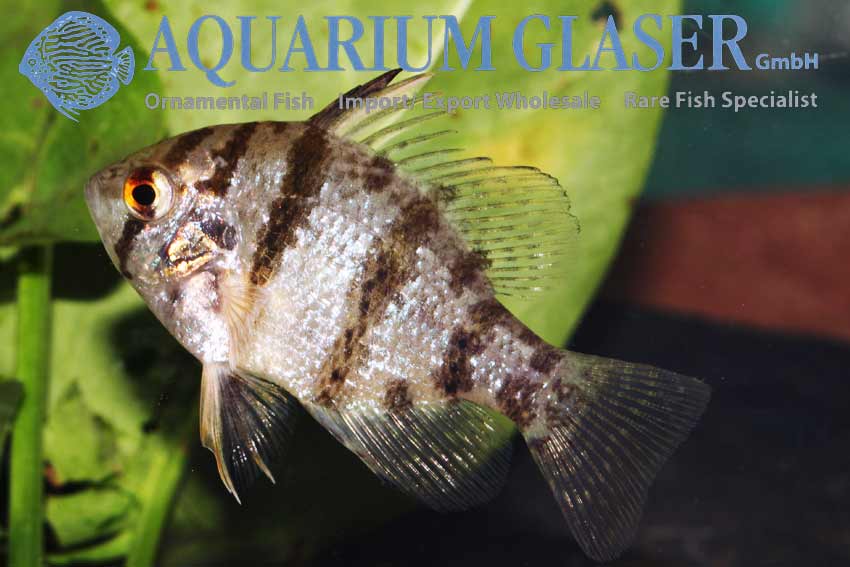
Everything that has been said for the Bluespotted sunfish is also true for the Blackbanded sunfish, E. chaetodon, that also occurs in the wild along with its cousin.
We have received very nice, fully grown German bred ones!
For our customers: the fish have code 803702 on our stocklist. Please note that we exclusively supply the wholesale trade.
Lexicon: chaetodon: ancient Greek, means “with hairlike teeth”
Common name: Blackbanded sunfish
Text & photo: Frank Schäfer
Lepomis gibbosus

The pumpkinseed (Lepomis gibbosus) is one of the most beautiful coldwater fishes. Moreover it has a very interesting behaviour. The species originates from central parts of the North American continent. The continental climate (hot summers, cold winters) makes the pumpkinseed a hardy fish and so it was transferred by humans to many regions as a foodfish.
To Europe it was brought around 1880 for the first time. Since then it became a native fish in Europe but was not able to settle over the whole continent. Nowadays the pumpkinseed is blamed as an unwanted and useless species in Europe. In its natural habitat the fish grows up to 25 cm, but in Europe it stays small. How come? Indigenous North American populations of the pumpkinseed serve as food fish for many predators. The strategy of the pumpkinseed is a a very high reproduction rate. In Europe these predators are missing what leads to a mass-reproduction and the fish stay dwarfish. This phenomenon is also known from other fish species. The perch (Perca fluviatilis) also becomes dwarfish where predators are missing. And so the pumpkinseed usually grows only up to 5-10 cm in Europe.
In aquaria the fish can become much older than in nature. Like all fish the pumpkinseed can grow its whole live through and so aquarium specimens can grow to a captial size. In the garden pond, on the other hand, they usually stay small (around 15 cm). With growing age the adaptability to changes in the enviroment lessenes and so most pumpkinseeds die at the age of around 5 years due to weatherchanges or something similiar. It is wise to buy small individuals (4-5 cm) as their adaptability is high and they easily adopt to live in the new environment.
The garden pond for pumpkinseeds should contain shallow parts with fine sand. Good growth of submerged plants is also important for the fish. Clear and clean water ist preferred. Pumpkinseed are small preators which feed on insect larvae, amphibian larvae, small fish and so on. They can be fed easily with frozen bloodworm, but will almost ever refuse dried food. Males become bigger than the females and are more colourful. A pairbinding is not known in the species, the male will readily mate with any females that will come around. The males defend territories where they take care of the brood until the fry swims free.
For our customers: the animals have code 882500 on our stocklist. Please note that we exclusively supply to the wholesale market.
Lexicon: Lepomis: ancient Greek, means “with scales on the operculum”. gibbosus: Latin, means “humped”
Common name: Common Sunfish, Pumpkinseed
Photo: B. Migge / Aqualog archieves Text: Frank Schäfer
Lepomis cyanellus

This is a close relative of the Pumpkinseed. Lepomis cyanellus, the Green Sunfish, is only very occassionally found in the trade. It differs from L. gibbosus by the much larger mouth. The Green Sunfish also becomes much larger than its cousin, about 30 cm. Thus it represents a beautiful inhabitant for large coldwater aquaria and garden ponds. Our animals are German pond bred and currently 7-9 cm long.
For our customers: the animals have code 882203 on our stocklist. Please note that we exclusively supply the wholesale trade.
Lexicon: cyanellus: Latin, means “blueish”
Common name: Green Sunfish
Text & photo: Frank Schäfer
Centrarchus macropterus

The Flier was a very popular aquarium fish some decades ago; nowadays it is somewhat “out of fashion”. This is very unjustified, as is shown by the wonderful, 8-12 cm long specimens we currently have in stock.
Fliers are calm, majestic fishes that are real eyecatchers for every well planted coldwater aquarium. In the garden pond, these fishes also look extremely beautiful when they stand in shallow water over sandy ground and the sun makes them glitter as if they were powered with gold dust.
Young specimens show a well defined ocellus in the soft part of the dorsal fin which gets lost when the fish gorow to adult ages.
For our customers: the fish have code 803106 on our stocklist. Please note that we exclusively supply the wholesale trade.
Lexicon: Centrarchus: ancient Greek, menas “with spiny back”, referring to the spines of the anal fin. macropterus: ancient Greek, means “with large fins”.
Text & photo: Frank Schäfer





